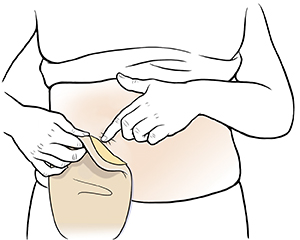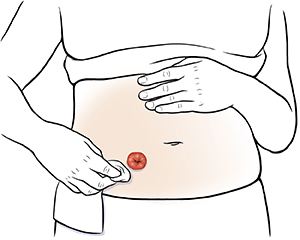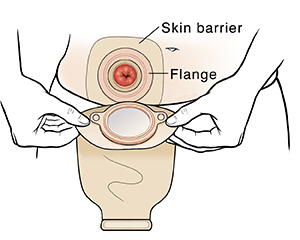Your care team showed you how to change your pouch in the hospital soon after your surgery. The information below helps you remember the steps you need to follow to change your pouch. As a rule, a drainable pouch needs to be changed every 5 to 7 days. You will be emptying it more often, usually 6 to 8 times a day, when it's about 1/3 full. Don't let it get more than 1/2 full.
Home care
Gather the following supplies:
-
Plastic bags
-
Clean towel
-
Toilet paper
-
Extra skin protection
-
Soft washcloth
-
Scissors (if needed)
-
New pouch
Remove the used pouch:
-
Sit on or next to the toilet.
-
Empty the used pouch into the toilet if necessary.
-
Starting at the upper edge of the skin barrier, carefully push the skin away from the barrier with one hand. Slowly peel back the skin barrier with the other hand.
-
Peel all the way around the skin barrier until the pouch comes off.
-
Seal the pouch in a plastic bag. Then put it in a second plastic bag. Throw it away in a trash bin.
Clean around the stoma:
-
Wipe any stool off the skin around the stoma with toilet paper.
-
Clean the skin with warm water and a soft washcloth. Wash right up to the edge of the stoma. Pat the skin dry with a clean towel.
-
If needed, put on extra skin protection, such as moisture barrier cream or powder.
Put on the new pouch:
-
Peel the backing off the skin barrier.
-
Place the precut skin barrier over the stoma. If you don’t use a pouch with a precut skin barrier, size and cut the opening (1/16 inch bigger than the stoma). Then peel the backing off the skin barrier. Carefully place it over the stoma.
-
The pouch opening should point toward your feet.
-
If using a pouch with a clamp at the base, it may be easier to apply the clamp to the pouch first.
-
Snap the pouch onto the barrier flange (if you use a 2-piece pouch).
-
Press the barrier against your skin. Hold it in place for 45 seconds.
-
Clamp the tail of the pouch (if drainable or reusable).
-
Wash your hands with clean, running water for at least 20 seconds when you are done. (Hum Happy Birthday twice if you need a timer.) Or use a hand sanitizer that contains at least 60% alcohol. Handwashing is important if your hands are possibly soiled with stool.
When to call your doctor
Contact your doctor or seek medical care right away if you have:
-
Pus or foul-smelling drainage.
-
A stoma that separates from the skin or looks like it’s getting longer.
-
A stoma that is recessing (pulling back) into the belly.
-
Bulging skin around your stoma.
-
Blood in your stool. If there is a large amount, call 911immediately.
-
Change in the color of your stoma.
-
Fever of 100.4°F (38°C) or higher, or as directed by your doctor.
-
Chills.
-
Nausea or vomiting.
-
Increased pain in the belly or around the stoma.
-
No gas or stool made after 24 hours.




